Abstract
The relationship between the development of mediated online literature searching and the recruitment of medical librarians to fill positions as online searchers was investigated. The history of database searching by medical librarians was outlined and a content analysis of thirty-five years of job advertisements in MLA News from 1961 through 1996 was summarized. Advertisements for online searchers were examined to test the hypothesis that the growth of mediated online searching was reflected in the recruitment of librarians to fill positions as mediated online searchers in medical libraries. The advent of end-user searching was also traced to determine how this trend affected the demand for mediated online searching and job availability of online searchers. Job advertisements were analyzed to determine what skills were in demand as end-user searching replaced mediated online searching as the norm in medical libraries. Finally, the trend away from mediated online searching to support of other library services was placed in the context of new roles for medical librarians.
INTRODUCTION
The author graduated from library school in 1970 and did not recall the words computer or automation ever being spoken in any class. While working in medium to small public libraries through 1973, the only automation seen was a teletypewriter exchange service (TWX) machine for transmitting interlibrary loans between public libraries. A hiatus from the library field ended for the author in 1984 with an academic appointment with the requirement to learn about databases, Boolean logic, and operation of dumb terminals for purposes of online searching. For many, proficiency at online database searching during the 1980s became the most exciting and stimulating part of being a librarian. Having this unique knowledge and skill gave librarians increased visibility and status.
In the 1980s, demand for mediated online searches was strong in the health sciences and, as hypothesized by this study, there should have been a direct relationship between the development and expansion of mediated online searching and the recruitment of medical librarians to fill positions as online searchers as revealed in advertisements for such positions.
HISTORY OF ONLINE DATABASE SEARCHING
Under the leadership of Frank B. Rogers, the National Library of Medicine (NLM) initiated efforts to mechanize access to the growing volume of biomedical literature. Modern machine methods were first applied to the production of Index Medicus (IM) in the mid-1960s that led to the capability of searching IM with computers. The Medical Literature Analysis and Retrieval System (MEDLARS) became operational in 1964. It used a retrieval system that processed complex searches in batch mode without direct interaction with the computer. In 1970, at the height of the use of this retrieval system, approximately 18,000 searches were completed with a turnaround time of forty to sixty days [1].
The first NLM experiments in real time, interactive online access to the MEDLARS bibliographic database were conducted in 1970–71. MEDLINE (MEDLARS online) became operational in 1971 with interactive searching available from remote terminals in ten regional and fourteen large academic medical libraries. By February 1972, fifty-five cities had access to MEDLINE. By 1973, the potential for commercial development of online scientific search systems and services was apparent and the rapid development of computer and communications technology made more extensive use of online retrieval systems feasible [2]. As computer capacity expanded, service was extended to larger hospital libraries and other institutions. With the formation of consortia, smaller medical libraries also began to access MEDLINE. By 1978, 900 institutions had online access to the MEDLINE database.
NLM also leased database tapes to commercial companies who then acted as information vendors, selling access to the information from their own computers, using their own access software. Widespread searching of online commercial databases specifically by academic reference librarians began in the late 1970s and early 1980s. Virtually all of the initial users of online retrieval systems were trained searchers who learned the specific commands, protocols, features, responses, and messages of each system they used [3].
Werner surveyed the state of online searching in health sciences libraries in the United States and Canada in 1976 to 1977 [4]. By that time, online searching was part of the normal reference function and was handled by all members of the reference staff in most institutions with separate reference departments. While timesaving did occur when online searching replaced manual searching, the number of MEDLINE searches had increased 60% by 1976–77. Staffing levels increased some, but the average number of librarian-performed searches was an astonishing 1,400 to 1,600 searches per year! In Werner's survey, only 0.2% of searches were reported to be conducted by the user alone; 0.5% were conducted by the user with assistance available. In Werner's study, the impact of the initiation of online searches was very positive for health sciences libraries and librarians; users' expectations of library services increased (95% agreed), and librarians felt users had a more positive attitude about library staff technical expertise (88% agreed).
By 1981, mediated MEDLINE searches reached two million per year and personal computers had become commonplace in the workplace. When a critical mass of personal computers was reached, services oriented to end users of online databases began to appear. In 1983, BRS Information Technologies and Dialog offered online services evenings, weekends, and holidays when their giant computers were underused. Both companies simplified their online searching software to make searching easier for end users, lowered their prices, and experienced modest success [5]. This practice was seen as nothing less than a revolutionary breakthrough in the world of online searching.
Pioneers in the development of applications for end-user searching included medical libraries: the University of Ottawa; California State University–Long Beach; Drexel University; Graham Laboratories Pharmaceutical Research Division; Swedish Hospital Medical Center, Seattle; Welch Medical Library of Johns Hopkins University; and Whitney Information Services at General Electric. Medical libraries in the second wave included: St. Elizabeth Hospital, Boston; University of Maryland, Baltimore; and University of Minnesota [6].
In response to the increasing availability of microcomputers, NLM developed a personal computer-based search interface for health professionals who wanted to do their own searches. The software package, Grateful Med, was introduced in 1986 [7].
The real breakthrough in end-user searching came in the mid-1980s with the introduction of CD-ROM technology. CD-ROM technology promised to bring database searching closer to the end user. MEDLINE on CD-ROM first appeared in early 1987 and was one of the first products to enjoy widespread distribution in libraries. Hospital and medical libraries quickly embraced the technology as a cost-effective alternative to metered online searching. CD-ROM technology offered a way of promoting information based on a fixed annual cost as opposed to the variable cost of online connect charges. There were eight CD-ROM versions of MEDLINE by the mid-1980s, making it clear that CD-ROM technology was finding a niche in libraries and information centers [8].
The Internet has effectively overcome many barriers to end-user online access and use. NLM was quick to identify the Internet as an important mechanism for the dissemination of information and released Internet Grateful Med (IGM), an Internet-accessible version of NLM's Grateful Med search software, in April 1996 [9]. On June 26, 1997, Vice President Al Gore announced that access to MEDLINE over the Web would be free of charge [10].
PREVIOUS JOB ADVERTISEMENT STUDIES
Medical librarian job advertisements have been studied previously. Palmer studied how changes in the profession were reflected in job advertisements in MLA News for medical librarians from 1961 to 1977 [11]. He reported that advertisements began to mention automation in 1965 for positions in technical services or serials control and, during the six-year period from 1965 to 1970, continued to reflect a growing interest in library automation and computer-based reference service. He noted that the dramatic intensification of interest in automated reference service beginning in 1972 could be traced to the introduction of MEDLINE in October 1971. By 1977, an impressive 43% of all advertised positions mentioned automated reference service.
Schmidt and Swanton looked at qualifications sought by employers who advertised for librarians in MLA News in 1977 to 1978 [12]. The special experience or training requirement that was most frequently requested in the advertisements was for NLM online experience including seventy-eight positions that preferred it and seventy-six that required it out of a total of 414 advertisements.
In 1986, Stroyan looked at qualifications sought by employers in MLA News job advertisements [13]. As with Schmidt and Swanton, Stroyan found that online bibliographic experience or training was most frequently requested and was included in 55% of positions advertised.
Nordland analyzed job advertisements in MLA News from January through December 1991 [14]. Subject background and online skills were the two most sought after qualifications in those ads.
CURRENT STUDY METHODOLOGY
MLA News was chosen as the source for advertisements for positions for medical librarians. MLA News, a publication of the Medical Library Association, began publication on an irregular basis in 1961. MLA now publishes ten issues a year, and the MLA News has always included an employment opportunities section under a variety of titles. MLA News is the most important source of classified advertising for medical library positions in that it is devoted solely to medical librarianship and it is sent to all MLA members as part of their membership dues. While this publication certainly does not represent the sole source of job opportunities within the field of medical librarianship, the volume and content of MLA News job advertisements can give a strong indication of the trends in the demand for medical librarians and their special skills and knowledge.
Content analysis classifies, quantifies, summarizes, and interprets data from text by selected characteristics. For this study, this type of analysis was performed using the advertisements in the positions available portion of the employment opportunities section in MLA News as the data source. The jobs advertised in all 290 issues of MLA News from 1961 through 1996 were analyzed. Because such a large number of ads were analyzed, the sole attempt to eliminate duplication was the deletion of those advertisements that were exact replicas of those in the immediately preceding issue.
The type of health sciences library that placed the advertisement was noted (Table 1) and positions offered were analyzed (Table 2). Using Rayman's methodology, “when multiple duties were listed, the first library position/function given was used to determine the position designation” [15]. The public services category was defined broadly to include reference, circulation, reserve, interlibrary loan, clinical, outreach and liaison, public relations, and marketing. Searching was often included as a task in these job descriptions. The audiovisual category included librarians whose jobs focused on any media, learning resources, microcomputer, or computer-assisted instruction. Titles and descriptions of positions for online searchers showed great variation. Online or literature searcher, online or literature analyst, and online or database services coordinator or director were all included as searchers. The technical services category included cataloging, acquisitions, serials, and collection management. Following Zhou's methodology, “For positions of department heads, unit heads, and assistant or associate directors whose managerial responsibilities are confined to mainly one division, the author decided to classify them with their respective divisions rather than with the administrator's division” [16]. Advertisements placed in this category had to include words like manages, plans, develops, coordinates, organizes, supports, promotes, or represents. Following Stroyan's methodology, program coordinators were included as administrators [17]. Systems librarians included automation, microcomputer, and network services librarians. The “other” category included archivists and history of medicine, rare books, and special collection librarians, as well as editors, indexers, abstractors, and positions with insufficient information to assign a category.
Table 1.
Number of job advertisements in MLA News by type of library
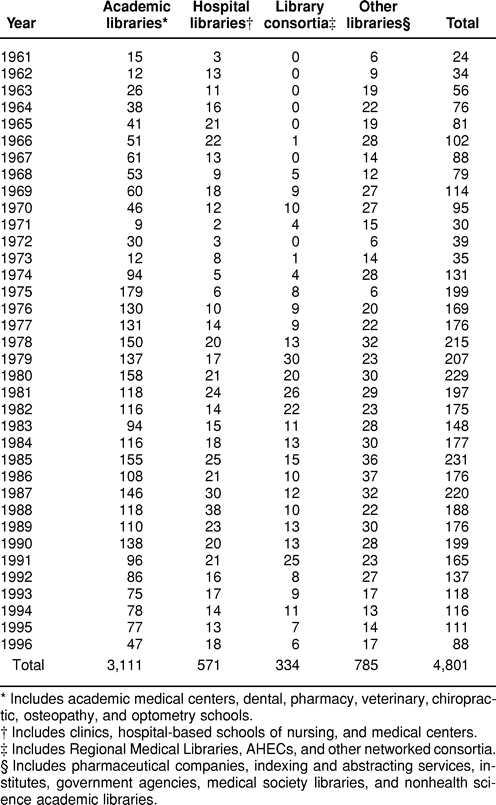
Table 2.
Number of job advertisements in MLA News by position description
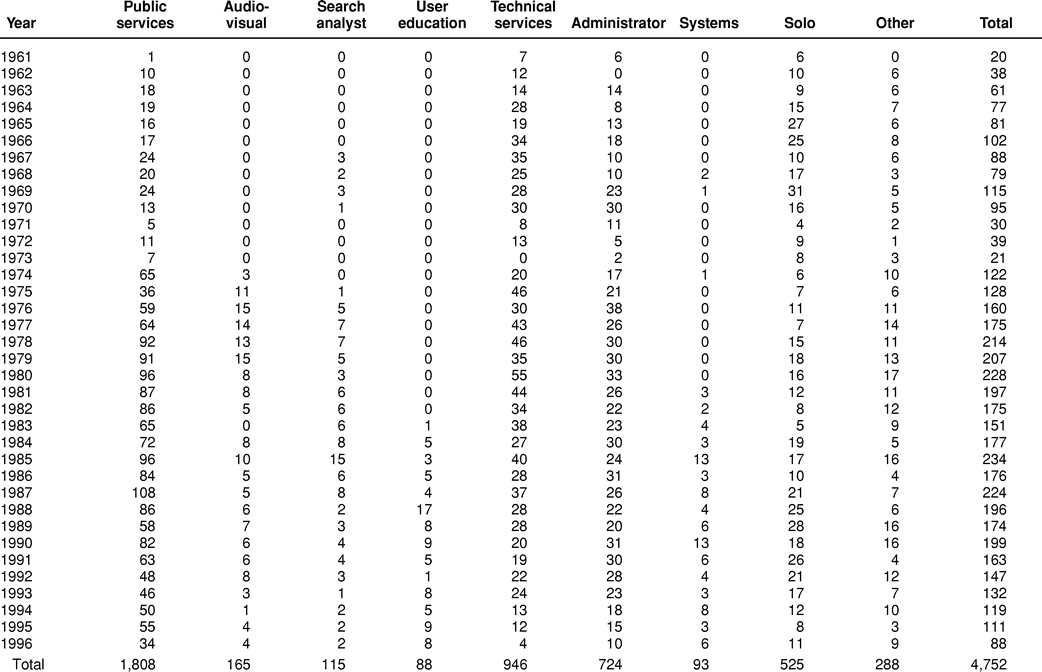
RESULTS
Early MLA News job advertisements
Advertisements appearing in the earliest issues of MLA News were very brief, typically only two to four typewritten lines, and included only the barest information. The library was identified by type; job requirements were stated; and benefits were noted. Vague phrases like “to participate in all professional work” along with the name and address of the institution and the contact person were typical of the information given. An advertisement placed in the very first issue of MLA News was illustrative: It read: “Assistant Librarian: In charge of Technical Services. Month's vacation; good fringe benefits. Position open June 1st.”*
Automation was mentioned in early MLA News job advertisements, most often in relation to positions in serials processing and later in circulation. The first reference to automation was in the August 1963 MLA News (issue #6). Biological Abstracts advertised for a bibliographer with an interest in mechanized systems and Indiana University was looking for a serials librarian with “Some knowledge of principles of automation required, but not medical library experience.” In February 1966 (issue #16), Pennsylvania State University described an opening for a machine methods librarian, but no description of the position was given.
Advertisements for online searchers
The first advertisement for a MEDLARS searcher appeared in February 1967 (issue #20) for the University of Michigan. Online searching was also mentioned in an ad for an information specialist at the Syntex Research Library in Palo Alto, California: “Must have experience in a technical library in framing questions for computer retrieval and ability to perform literature searches.” By the summer of 1969, the University of California–Los Angeles (UCLA), the University of Alabama, the College of Physicians and Surgeons of Philadelphia, and the New York Academy of Medicine had all advertised for MEDLARS searchers. McGill University advertised for a medical librarian with “knowledge of current developments and advances in machine and systems techniques related to library operations and information retrieval desirable” in May 1970 (issue #34). In August 1970 (issue #35), Emory University placed an ad for a reference librarian/MEDLARS search analyst to formulate MEDLARS search requests. In November 1970 (issue #36), the University of Utah was looking for a reference librarian to “handle questions, MEDLARS and other literature searches.”
By the mid-1970s, advertisements such as the foregoing were becoming more frequent. There were five such ads in 1976, seven in 1977, and seven in 1978. The year with the largest number of requests for positions entitled searcher, search analyst, or the like was 1985 with fifteen. As Xu noted, this rate might reflect “a time gap from the implementation of new technology in libraries to the corresponding changes in library professional duties and responsibilities” [18]. His study on the impact of automation on job requirements and qualifications for catalogers and reference librarians in academic libraries found that requirements concerning the knowledge of such relevant skills did not immediately appear in job advertisements.
From 1961 through 1996, a total of only 115 job advertisements in MLA News were for positions specifically entitled online searcher or something comparable (Figure 1). This number did not reflect the total demand for online searching skills. Job advertisements for other public service positions that required or preferred experience or training in database searching totaled 1,329.
Figure 1.
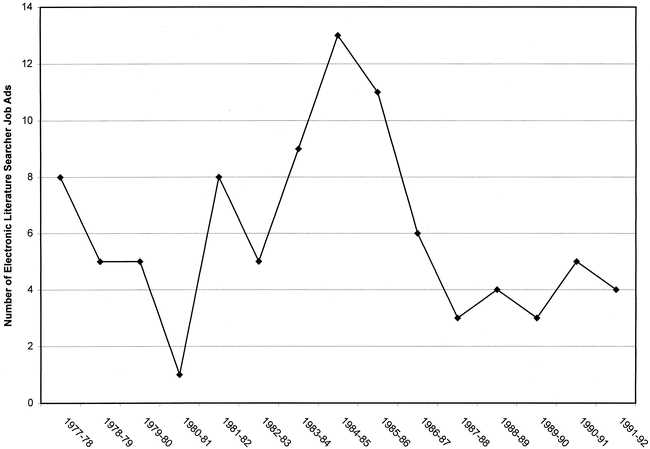
Numbers of job ads for electronic medical literature searchers published in MLA News, 1977–1992 Note that the highest number of ads was thirteen in 1984–85 and only exceed eight per year three times in fifteen years.
Specific advertisements for online searchers peaked at fifteen in 1985. In the 1990s, the highest number was four in 1990 and, in recent years (1993–1996) the numbers have dwindled to only one or two a year. Demand for online searching skills for public service jobs peaked at ninety-eight in 1987 and dropped to only twenty-five in 1996. This change might not indicate a decrease in the need or demand for these skills, but an acknowledgment of a basic and expected ability to perform database searching as a routine qualification for a professional position. As Xu stated, “once certain sorts of requirements or responsibilities become relatively commonplace, they might not always be mentioned in job descriptions” [19].
Search activity statistics
The Association of Academic Health Sciences Library Directors (AAHSLD) collected statistics on database searching from 1977 to 1992 [20]. While these statistics did not include all medical library searching done in that time period, assuming that the trends reflect what was happening in most medical libraries would be reasonable. And the results were surprising (Figure 2). In 1977–78, the first year statistics on “Total Databases Accessed” were collected, 234,512 searches were reported. The numbers peaked at 307,665 in 1982–83. For the last year this statistic was reported, 1991–92, the number fell to 212,982. These trends in the levels of searching activity were not duplicated in the trends for the demand for full-time online searchers during this period (Figure 1). Search loads for librarians peaked quickly and remained at a very high level. At the same time, the number of positions advertised to perform specially mediated online search services never reached a very high level. It would seem that this demand for service did not create a large body of professional medical librarians whose primary job responsibility was online searching.
Figure 2.
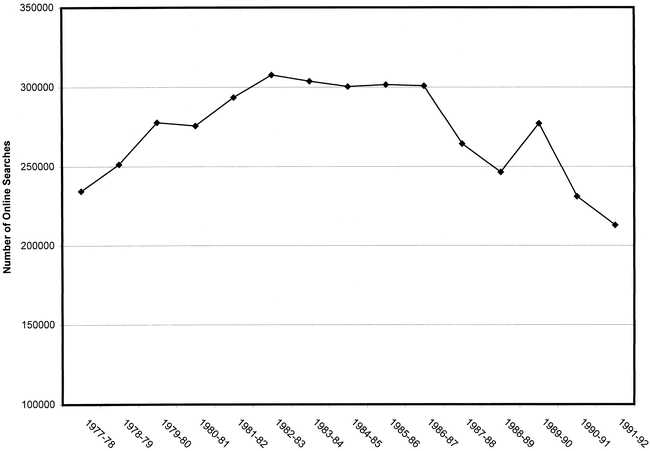
Numbers of online searches reported to AAHSLD, 1977–1992 Note that the number of searches remains well over 200,000 per year for the entire period.
DISCUSSION
Impact of end-user searching
In 1988, Brahmi described the impact of CD-ROM MEDLINE on mediated searching at Indiana University School of Medicine Library [21]. Her preliminary data led her to believe that it had little impact on mediated searching. Washington University School of Medicine reported a drop of 18% in mediated search activity [22]. A more recent report at Yale might be seen as typical [23]. While only ten years ago, reference librarians spent more than half of their time performing mediated computer searches, there was almost no demand for this service in 1995–96 in the Yale environment. Mediated searching decreased by 96%, while end-user searching increased by the same percentage [24].
Reference librarians in Association of Research Libraries (ARL) institutions were surveyed in 1991, 1994, and 1997 to determine how they were incorporating electronic information resources into their reference activities and the effect of these resources on library services [25]. The 1997 ARL survey found that while intermediary search services had not been abandoned in academic research libraries, they were dwindling in number and most were experiencing sharp declines in the numbers of searches performed. The results of the ARL study suggested a continuation of a trend that was well under way in the earlier surveys. End-user online searching on commercial search services continued to grow in popularity. Traditional online vendors were providing Internet access to their databases and software companies were developing more powerful and intuitive search tools for end users. The Internet has removed the barrier that once made online information products and services the unique domain of librarians. End-user online services in libraries are now seen as a mainstream offering.
NEW ROLES FOR MEDICAL LIBRARIANS
Braude's 1996 Janet Doe Lecture suggested that the profession of health sciences librarianship was undergoing an identity crisis:
Our hallway conversations, our e-mail discussions, and our literature are filled with the kinds of questions that reflect this identity crisis—who are we? why are we? where are we? We exhibit at one time or another such behavioral affects as free floating anxiety, depression, insomnia, and extensive self-criticism, an academic form of that old Medieval standby, self-flagellation. We question our contribution, our area of expertise, and our turf. [26]
The demand for online searchers and their services has declined and there has been a concomitant decrease in the levels the job status and job satisfaction the activity had formerly brought. These are among the factors that have put librarians “under pressure to seek new roles and explore information needs and service opportunities in the field” [27]. If searching is currently not being done at the same levels as before, what are librarians doing instead?
A recent survey of special librarians has found that they envision their roles in the future as evolving around six key functions: consultant, analyst, facilitator or trainer, intranet content manager, project planner and marketer, and corporate knowledge manager [28]. These tasks involve a completely different set of skills, with the emphasis shifting from technical skills in the library to communication, facilitation, training, and management skills.
Grajek and colleagues at Yale have reported that medical librarians currently spend their time on end-user training and consultation, hardware and software troubleshooting, database and system selection, and Web development [29]. The need for these kinds of activities began with the introduction of online public access catalogs. The constant changes in technology have resulted in the growth in the demand and need for instruction in the use of library resources and services. Many libraries have made end-user instruction an integral part of their library services.
End-user instruction
Xu found bibliographic instruction responsibility specified in job ads for reference librarians as early as 1978 [30]. By 1990, over half specified such duties. The current study found the first indication of the demand for instruction in end-user searching as a public service responsibility in medical libraries in January 1983 (issue #151) when Emory University Dental School advertised for a reference librarian/coordinator of library instruction to coordinate orientation and user instruction (Figure 3). The 1988 calendar year saw the highest number of job advertisements for user education librarians, seventeen. As early as 1986, the editors of End User Searching in the Health Sciences sensed that this change in function, from searcher to educator, had already taken root [31]. This timing coincided with the debut of MEDLINE on CD-ROM and the recognition that “a prerequisite for end-user searching is training and education” and that “the role of training will naturally fall in the domain of the librarian/search analyst, who is considered an expert in database searching” [32].
Figure 3.
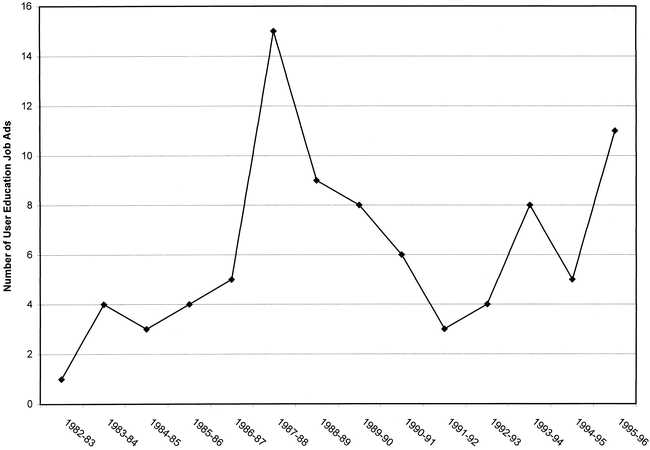
Numbers of job ads for user education librarians published in MLA News, 1982–1996 The first job ad in this category appeared in 1983.
The statistics on educational activities in medical school libraries reported by AAHSLD began with the academic year 1985–86. MEDLINE on CD-ROM appeared the following year. The number of educational program sessions reported by AAHSLD libraries jumped immediately and dramatically; 4,080 sessions in 1985–86, 7,502 in 1987–88, and over 10,000 in 1989–90 (Figure 4).
Figure 4.
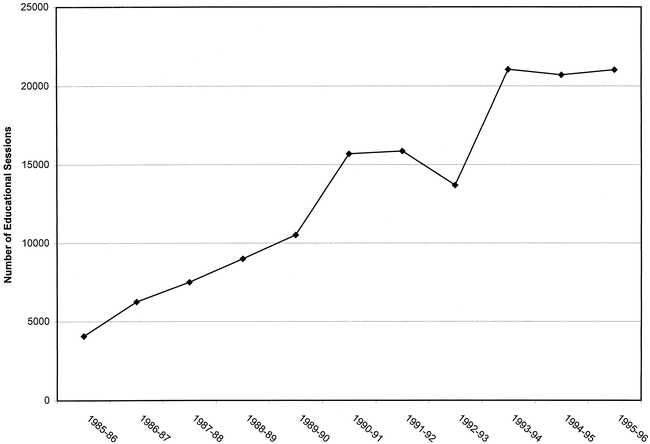
Numbers of educational sessions reported to AAHSLD, 1985–1996 Note the dramatic increase in numbers of educational sessions concurrent with the spread of the use of CD-ROMs in medical libraries. Reporting of statistics for this area began in 1985.
Eighty-six positions for user education librarians have been advertised in MLA News in fourteen years (1982–96). This number compared very favorably with the ninety online searcher positions advertised over a similar time span (1982–96).
Web
Web development was one of the online searching replacement tasks mentioned by Grajek [33]. Smith studied the demand for Internet skills between 1991 and 1995 in health sciences library positions [34] and found that the percentage of positions requiring Internet skills increased during this time, reflecting the growing importance of the Internet and the skills needed for its use in the library.
In 1995, NLM provided funding to seven institutions to develop training programs that would promote and foster new roles for librarians, especially librarians working in clinical and research settings outside a library [35]. Under this program, librarians at Vanderbilt University's Eskind Biomedical Library are being trained to be integrated into teams doing clinical rounds, searching and interpreting the medical literature. Librarians are also creating a searchable electronic database of clinical questions.
CONCLUSION
Despite the high volume of online searching done by medical librarians, large numbers of advertisements for jobs with searching as the core function never materialized. This fact suggested that online literature searching never really rose to the status of a distinct subspecialty of health sciences librarianship. It remained a skill, an increasingly vital skill, one of many, necessary to the conduct of reference services in medical libraries. Also, the use of this skill for bibliographic searching has become more and more transparent in public services. It has been so incorporated into daily activities that it has simply gone unnoticed. Fisher recently stated,
A part of me misses the good old days when everyone had to come to us for computer searches. There was a real feeling of accomplishment when you ran a search for someone in need. There was the immediate sense of gratification that I had helped out in some great way. Those kinds of feelings just aren't generated as easily today. Our contribution is transparent and so must be the gratification. [36]
Librarians individually and the profession as a whole rose in stature with the initiation of mediated online services. As early as 1979, Werner reported the clear and positive impact of online services on the image of librarians [37]. For librarians, online searching was interesting, challenging, and fun. It was a major source of job satisfaction. As their responsibilities in this area diminish, will they lose the gains made in positive public opinion, as each information seeker becomes an online searcher?
As the future of job opportunities in medical librarianship is considered, Braude's 1996 Jane Doe Lecture offers some guidance [38]. He predicts that health sciences librarians will continue to evolve by modifying their educational preparation, learning to combine skills of selection and organization of information with skills in the effective use of information technology tools, and by adding the ideals of service to individuals and society, thus create new roles and new jobs for the health sciences librarians of the future.
Acknowledgments
My sincerest thanks go to Gwen Snodgrass and Marty Rosen for inspiration, Kellie Kaneshiro and Kathy Rogers for collection, and Karen Little for correction.
Footnotes
*Gender preferences and age requirements were boldly stated, e.g., “Woman preferred”; “Cataloger (woman)” and “Prefer individual in age range 30–40”; “Age limit—55 years.” There were also requirements for nonprofessional skills such as the ability to walk stairs and/or drive a car.
REFERENCES
- Doszkocs TE, Rapp BA, Schoolman HM. Automated information retrieval in science and technology. Science. 1980 Apr 4;208(4439):25–30. doi: 10.1126/science.6987735. [DOI] [PubMed] [Google Scholar]
- Ibid., 25. [Google Scholar]
- Williams ME. Electronic databases. Science. 1985 Apr 26;228(4698):445–56. doi: 10.1126/science.3885395. [DOI] [PubMed] [Google Scholar]
- Werner G. Use of on-line bibliographic retrieval services in health sciences libraries in the United States and Canada. Bull Med Libr Assoc. 1979 Jan;67(1):1–14. [PMC free article] [PubMed] [Google Scholar]
- Janke RV. BRS/After Dark: the birth of online self-service. Online. 1983 Sep;7:12–29. [Google Scholar]
- Janke RV. Online after six: end user searching comes of age. Online. 1984 Nov;8:15–29. [Google Scholar]
- Wood FB, Wallingford KT, Siegel ER. Transitioning to the Internet: results of a National Library of Medicine user survey. Bull Med Libr Assoc. 1997 Oct;85(4):331–40. [PMC free article] [PubMed] [Google Scholar]
- Kittle PW, Wood EH, CD-ROM: the past and the future. In: and Wood MS. ed. CD-ROM implementation and networking in health sciences libraries. Binghamton, NY: Haworth Press. 1993 45–55. [Google Scholar]
- National Library of Medicine. Internet Grateful Med user's guide. [Web document]. [20 Jul 1999]. <http://igm.nlm.nih.gov/splash/IGM.survival.guide.html>. [Google Scholar]
- National Library of Medicine. Press release: free MEDLINE. [Web document]. [November 13, 1998]. <http://www.nlm.nih.gov/news/press_releases/letter free_medline.html.>. [Google Scholar]
- Palmer JW. Changes in medical librarianship: a content analysis of job advertisements in the MLA News, 1961–1977. Bull Med Libr Assoc. 1978 Oct;66(4):464–6. [PMC free article] [PubMed] [Google Scholar]
- Schmidt D, Swanton J. Qualifications sought by employers of health sciences librarians, 1977–1978. Bull Med Libr Assoc. 1980 Jan;68(1):58–63. [PMC free article] [PubMed] [Google Scholar]
- Stroyan S. Qualifications sought by employers of health sciences librarians, 1986. Bull Med Libr Assoc. 1987 Jul;75(3):209–13. [PMC free article] [PubMed] [Google Scholar]
- Nordland CL. Qualifications sought by employers of health sciences librarians, 1991. [Master's research paper]. Kent, OH: Kent State University School of Library and Information Science. 1992 [Google Scholar]
- Rayman R. Employment opportunities for academic librarians in the 1970s: an analysis of the past decade. Coll Res Libr. 1981 May;42:229–34. [Google Scholar]
- Zhou Y. Analysis of trends in demand for computer-related skills for academic librarians from 1974 to 1994. Coll Res Libr. 1996 May;57:259–72. [Google Scholar]
- Stroyan. op. cit., 212. [Google Scholar]
- Xu H. The impact of automation on job requirements and qualifications for catalogers and reference librarians in academic libraries. Libr Resour Tech Serv. 1996 Jan;40:9–31. [Google Scholar]
- Ibid., 29. [Google Scholar]
- Association of Academic Health Sciences Library Directors. Annual statistics of medical school libraries in the United States & Canada. Houston, TX: The Association, 1978–1993. [Google Scholar]
- Brahmi FA. The effect of CD-ROM MEDLINE on online end user and mediated searching. Med Ref Serv Q. 1988;7(4):47–56. doi: 10.1300/j115v07n04_04. [DOI] [PubMed] [Google Scholar]
- Salisbury L, Toombs HS, Kelly EA, Crawford S. The effect of end-user searching on reference services: experience with MEDLINE and Current Contents. Bull Med Libr Assoc. 1990 Apr;78(2):188–91. [PMC free article] [PubMed] [Google Scholar]
- Grajek SE, Helenius M, Marone RK, Roderer NK. The MEDLINE experience at Yale: 1986–1996. Med Ref Serv Q. 1997;16(4):1–18. doi: 10.1300/J115V16N04_01. [DOI] [PubMed] [Google Scholar]
- Ibid, 12. [Google Scholar]
- Tenopir C, Ennis L. The digital reference world of academic libraries. Online. 1998;22(4):22–8. [Google Scholar]
- Braude RM.. On the origin of species: evolution of health sciences librarianship. Bull Med Libr Assoc. 1997 Jan;85(1):1–10. [PMC free article] [PubMed] [Google Scholar]
- Guise NB, Kafantaris SR, Miller MD, Wilder KS, Martin SL, Sathe NA, Campbell JD. Clinical medical librarianship: the Vanderbilt experience. Bull Med Libr Assoc. 1998 Jul;86(3):412–6. [PMC free article] [PubMed] [Google Scholar]
- Church D. Breaking free of the reference shackles. Inf Outlook. 1999 Mar;3(3):18–20. [Google Scholar]
- Grajek. op. cit., 12. [Google Scholar]
- Xu. op. cit., 28. [Google Scholar]
- Wood MS, Horak EB, and Snow B. eds. End user searching in the health sciences. New York, NY: Haworth Press. 1986 [Google Scholar]
- Ibid. 111. [Google Scholar]
- Grajeck. op.cit., 12. [Google Scholar]
- Smith AM. Internet skills: an analysis of position advertisements 1991–1995. Bull Med Libr Assoc. 1997 Apr;85(2):196–8. [PMC free article] [PubMed] [Google Scholar]
- Guise NB, Kafantaris SR, Huber JT, Lynch F, Epelbaum M, Pfeiffer J. Developing a culture of lifelong learning in a library environment. Bull Med Libr Assoc. 1999 Jan;87(1):26–36. [PMC free article] [PubMed] [Google Scholar]
- Fisher C. From the chair. Public Services Section Newsletter. Winter 1998 1(Received 1/99). [Google Scholar]
- Werner. op. cit., 12. [Google Scholar]
- Braude. op. cit., 9. [Google Scholar]


